FIDE August 2025 rating list published
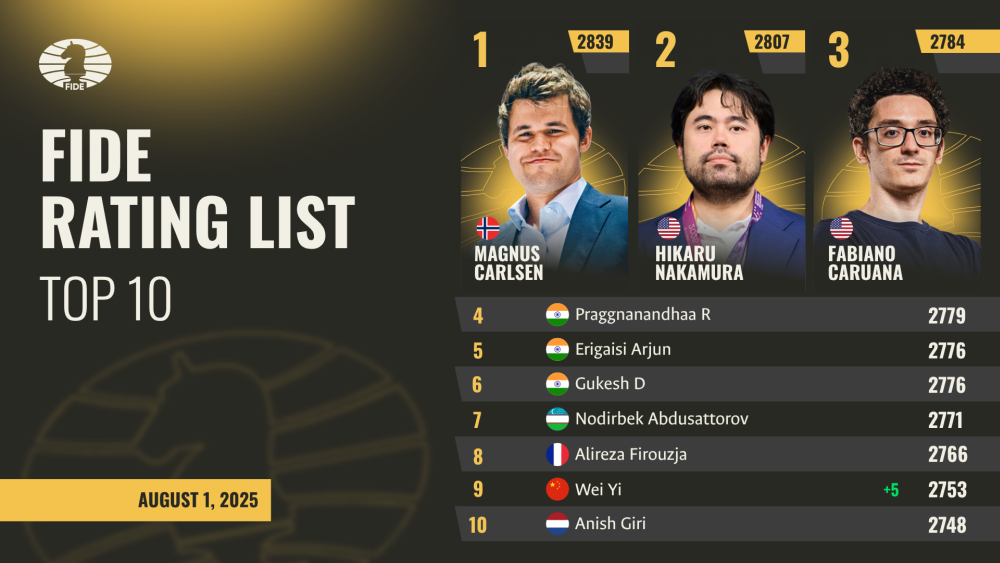
The August 2025 FIDE rating list was primarily influenced by the Women’s World Cup in Batumi, the Biel International Chess Festival and several other tournaments across Europe. The top 10 in the Open section remained unchanged from July, with the only exception being Wei Yi, who gained 5 rating points in his match against Levon Aronian. In contrast, the women’s top 10 saw several notable shifts following the Women’s World Cup 2025 in Batumi. Lei Tingjie (+8) consolidated her third position in the list and closed in on her title match opponent the reigning Women’s World Champion Ju Wenjun; Tan Zhongyi (+12) climbed to fourth place, while Zhu Jiner moved up one spot. The tournament winner, 19-year-old Divya Deshmukh (+15) reached her career-high 15th position and earned the Grandmaster title. Photo: Anna Shtourman Biggest gains in the top 100 (Open and Women) Schippke, Manon WIM FRA 2374 (+176) Prishita Gupta WFM IND 2353 (+135) Balabayeva, Xeniya WGM KAZ 2371 (+39) Kiolbasa, Oliwia IM POL 2393 (+32) Garifullina, Leya IM FID 2477 (+27) Kamalidenova, Meruert IM KAZ 2349 (+25) Theodorou, Nikolas GM GRE 2646 (+21) Divya Deshmukh IM IND 2478 (+15) Tabatabaei, M. Amin GM IRI 2673 (+14) Martinez Alcantara, Jose Eduardo GM MEX 2636 (+14) Salem, A.R. Saleh GM UAE 2640 (+13) Photo: Vivian Passig WIM Manon Schippke (pictured above) was the biggest rating gainer in July, earning a whopping 176 points in three competitions across France. The 18-year-old player from France broke into the top 100 Women and jumped straight to 9th position in the top female juniors list. WFM Prishita Gupta (pictured below) also debuts in the top 100 Women following her standout performances in Championnat de Paris 2025 Masters (+75 points) and Open International d’Aix-en-Provence (+60 points). Remarkably, the Indian teenager has earned over 400 (!) rating points over just the past two months. Photo: Shahid Ahmed Another overperformer in the Open International d’Aix-en-Provence is Leya Garifullina who collected 27 rating points in this competition, breaking into the top 20 Women for the first time in her career. WGM Xeniya Balabayeva made a triumphant return to the top 100 Women after a brief absence thanks to her excellent performance at the Oskemen Open 2025, where she gained 39 rating points, while Oliwia Kiolbasa added 32 points to her tally at the 11th Cesme International Open to reach 47th place in the women’s list – her best ranking since May 2023. Meruert Kamalidenova had stong showings in both the Vladimir Dvorkovich Memorial – Aktobe Open and the Women’s World Cup, boosting her rating by 25 points. Photo: Biel International Chess Festival Nikolas Theodorou (pictured above) made a major breakthrough in July following his successful runs in the Greece National Team Championship and Biel Chess Festival – Challengers. The 24-year-old GM from Greece earned 21 rating points to debut in the top 100 Open. Another newcomer to the top 100 Open is Jose Eduardo Martinez Alcantara who emerged as the winner of Lince Andujar Chess Open 2025, gaining 14 rating points along the way. Amin Tabatabaei added another title to his collection, lifting the trophy at the XXII Karpov International Chess Tournament (+14 points), while Saleh Salem returned to the top 100 Open after one-year absence, following a strong performance in the Biel Chess Festival – Masters.
World School Team Championship meets Smart Moves Summit
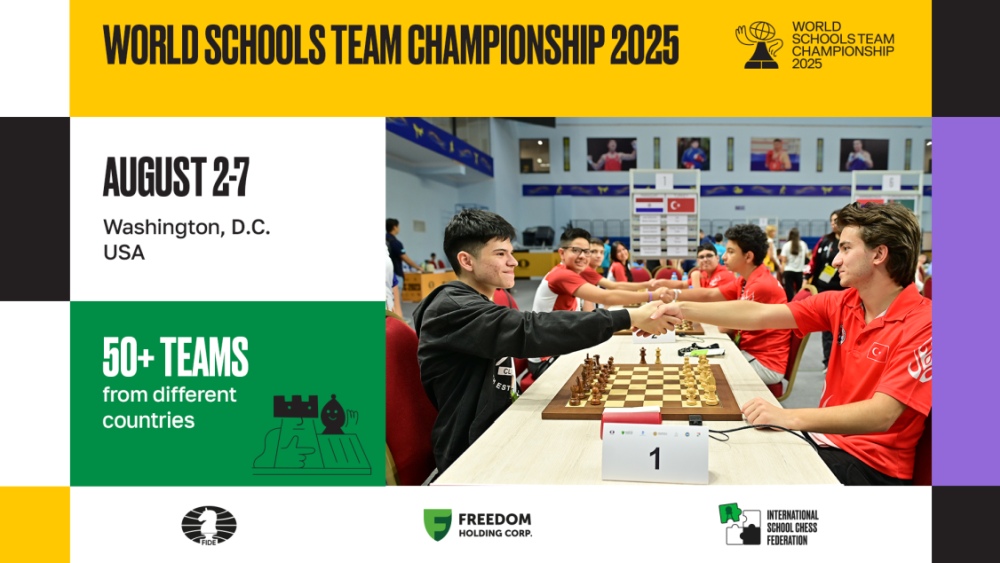
A major event in August bringing together school children, chess players, thought leaders and scientists set to transform how chess is perceived in the classroom The second edition of the World School Team Championship, a flagship event for school chess clubs, runs from 2 to 7 August at Episcopal High School – just 11 kilometers from downtown Washington D.C. More than 50 teams from different countries will compete in an eight-round Swiss-format tournament. “This will be one of the largest global children’s tournaments ever organized. With Freedom Holding covering all travel and accommodation, young players from across the globe will enjoy an experience that extends well beyond the board. Paired with the Smart Moves Summit on chess in education, this marks a milestone for scholastic chess and its role in childhood development,” said Emil Sutovsky, CEO of FIDE. Each team is fielding four main players, one reserve and one non-playing captain. Time control is 45 minutes plus a 10-second increment per move, with two games per day across four action-packed days. The inaugural edition of the World School Teams was held in Kazakhstan in 2023, laying the groundwork for this year’s expanded format. The 2025 event integrates competitive play with a major educational conference featuring scientists and experts in chess, learning, and life skills development. “The World Schools Team Championship is more than just a tournament – it’s a celebration of intelligence, unity, and the limitless potential of young minds. Bringing together teams from around the world, this event is a powerful example of how chess transcends borders and cultures. It helps develop critical thinking, resilience, and focus – skills essential for the 21st century,” said Timur Turlov, President of the International School Chess Federation. On 4-5 August, the Smart Moves Summit 2025 will bring together educational experts from over 30 countries, to discuss scientific research and showcase proven strategies on the role of chess in reshaping education and wellbeing. “As Artificial Intelligence reshapes every sector, educators and parents must find ways to equip students and children with critical thinking and resilience reflective of the 21st century challenges. This Summit brings together experts to share proven strategies,” Emil Sutovsky added. Spread across 15 sessions featuring panels, workshops, speeches and round-table debates, the conference will offer a host of fresh ideas and stimulating discussions across science, education and learning. It will deliver actionable conclusions and toolkits, to kicks-start the scale of school chess programs and using chess as a tool for self-improvement and personal development in both children and adults. “The Smart Moves Summit is a powerful reminder that education isn’t confined to classrooms: it lives in the lessons of strategy, patience, and foresight that chess teaches. By investing in this timeless game, we’re nurturing the minds of future leaders and empowering children with the tools to shape a smarter, more resilient world,” added Timur Turlov. Panels, round tables and master classes – What you will get from the Summit. Strategic Leadership in Global Chess EducationBrings together FIDE, national federations and partners to discuss long-term strategy, cross-sector collaboration and visionary leadership for global chess education. Chess in Early and Primary EducationExamines how introducing chess in preschool and primary settings supports executive functioning, emotional regulation, numeracy, language skills and social learning in inclusive, multilingual classrooms. More Than Equal – Levelling the Board for All Through Chess: Reviews global case studies on using chess to advance equity across gender, socio-economic status, ability and geography, moving from mere access to genuine agency. Tech on the Board Explores how digital platforms, tools and devices are transforming student engagement and learning through chess both inside and outside the classroom. Making the Case for Chess – Methodology, Policy, and Public Sector Partnerships: Looks at aligning chess-based learning methodologies with public education goals to build large-scale, lasting collaborations between chess organizations and government bodies. Chess + Math – Cognitive Games for Early Numeracy: A Master Class showing how to structure short, chess-based exercises tailored for early mathematics learners. Chess & Strategy Games Provides scalable, classroom-tested models that equip pre-service and in-service teachers with the skills and confidence to use chess and strategy games for cognitive development and interdisciplinary learning. The Power of Chess to Change Lives A case-study presentation, detailing how a chess program helped intellectual and social development among low-income youth. Sponsorship and Marketing at the Crossroads of Chess and EducationDiscusses how brands and organizations can sponsor school chess programs to support their growth while delivering value to partners. From Classroom to Cashflow – The Business of School Chess ProgramsAnalyzes how to build financially viable, pedagogically sound frameworks that sustain and scale school-based chess initiatives. Going Viral – How Social Media and Creators Are Redefining Chess Promotion (Cyber sport, Minecraft, Roblox)Investigates how social media, streaming platforms and digital influencers are reshaping the perception and reach of chess worldwide. Beyond the Final MoveReflects on lessons learned in school integration, technology use, partnership building and educational impact, and identifies urgent opportunities and challenges ahead. How to Train the TrainerShares methods for teaching chess in classrooms with neurodiverse learners and multiple language groups. Inclusive Chess EnvironmentsTechniques for teaching in neurodiverse, multilingual classrooms. A Statistical Spectroscope for Fair Play and Growing MindsExplores how analytics can reveal patterns in chess play to support ethical competition and cognitive development. Visit worldschoolteam2025.fide.com/summit for full details and to secure your seat. Early-bird pricing ending soon!
Five down, three to go: World Cup shakes up Women’s Candidates race
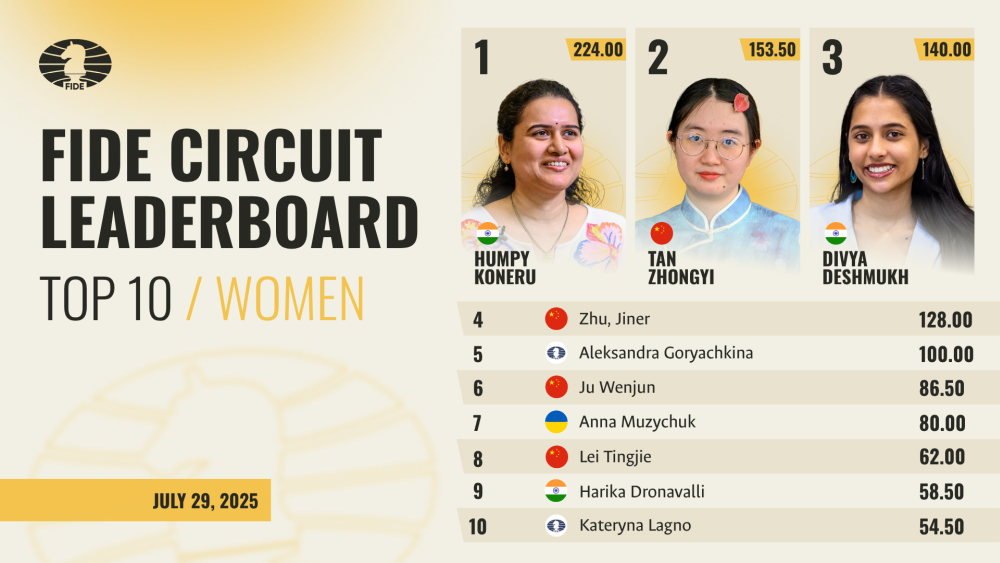
The latest 2025 Women’s World Cup outcome has rebalanced the landscape for the much-awaited 2026 Women’s Candidates tournament. The race for the eight spots in the 2026 Women’s Candidates is tightening. Two were secured through the Women’s Grand Prix – Zhu Jiner as winner and Alexandra Goryachkina as runner-up. Three more were decided at the recently concluded Women’s World Cup in Batumi, Georgia. Nineteen-year-old Indian talent Divya Deshmukh pulled off a hat-trick in Batumi. Her 1.5–0.5 tiebreak win over former World No. 2 Humpy Koneru not only gave her the title but also earned her a Grandmaster title – awarded automatically to the winner – and a place in the 2026 Candidates, one step away from a shot at the world title. Photo: Anna Shtourman Humpy Koneru and former Women’s World Champion Tan Zhongyi also qualified, finishing second and third, respectively. With five out of eight spots in the Candidates already determined, the players have just two more opportunities – the Grand Swiss in September (which carries two qualifying spots) and becoming the winner of the FIDE Women’s Events 2024–25 series. While the Grand Swiss is traditionally the strongest open tournament on the calendar, with qualification standards alone filtering the elite, the FIDE Women’s Events series, by contrast, operates on a cumulative points system. For context, players in the series are awarded Ranking Points (RP) based on performance in eight key events, which include the following women’s events: World Rapid Championship 2024 World Blitz Championship 2024 World Championship Match 2025 (only runner-up earns RP) Grand Prix Series 2024–25 (final standings used) World Cup 2025 Grand Swiss 2025 World Rapid Championship 2025 World Blitz Championship 2025 The final score of a player is calculated as the sum of the player’s RP in up to five of her best events. The World Cup in Batumi reshuffled the standings in the 2024–25 FIDE Women’s Events series. Humpy Koneru now leads comfortably with 224 Ranking Points, more than 70 ahead of Tan Zhongyi in second. The current top five players in the standings are all already qualified for the Candidates. World Champion Ju Wenjun holds sixth place (down from first, which she previously held), as she did not participate in the Women’s World Cup. As the defending World Champion, Ju does not need to play in the Candidates. The top player still in contention via the series is Anna Muzychuk, currently on 80 Ranking Points. Despite a strong performance and winning the final leg of the Women’s Grand Prix, she ultimately fell short of qualifying through that route. Photo: Przemek Nikiel Trailing Muzychuk are three contenders with between 54.5 and 62 points. Lei Tingjie – winner of the previous (2022–23) Candidates and unsuccessful title challenger – currently sits eighth on 62. Just behind her are veterans Harika Dronavalli (58.5) and Kateryna Lagno (54.5), both within striking distance. The final three spots in the Candidates will be decided across three key events. Two will go to the winner and runner-up of the Grand Swiss in September. The last place will be awarded to the winner of the FIDE Women’s Events 2024–25 series, based on Ranking Points earned in the Grand Swiss, the World Rapid, and the World Blitz. For those still chasing a spot, there’s little room for rest. The year will end with a demanding trio of events across all formats – classical, rapid and blitz – that could decide everything. We maintain a dedicated page on our website for the FIDE Women’s Events 2024-2025, featuring the latest information on eligible tournaments, current standings, and regulations. Visit: FIDE Women’s Events 2024-2025
Women’s World Cup 2025 closing ceremony: A night of music, memories, and triumph in Batumi
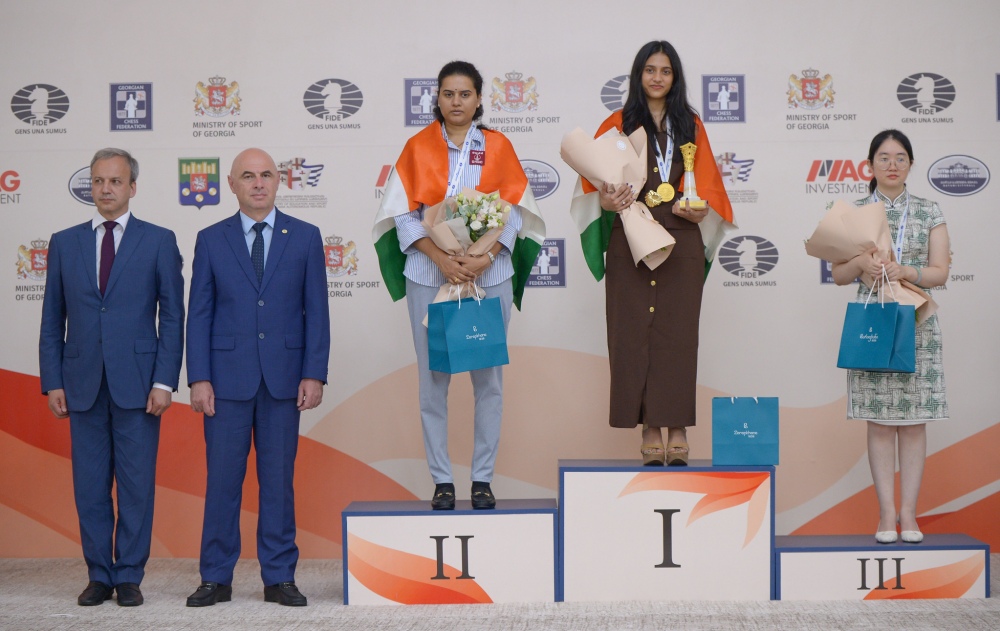
The closing ceremony of the 2025 FIDE Women’s World Cup was held in grand style at the Grand Bellagio Hotel and Casino in Batumi, Georgia, beginning at 7:30 PM with the stirring rendition of the Georgian National Anthem. The master of ceremonies warmly welcomed all distinguished guests, including FIDE President Arkady Dvorkovich and President of the Georgian Chess Federation Akaki Iashvili. Akaki Iashvili took the stage first, congratulating the winners and extending heartfelt thanks to everyone involved in the event’s success. In his remarks, he noted the dominance of Indian and Chinese players, and underlined the World Cup’s prestige as one of the longest-running events in the FIDE calendar. He also highlighted the celebration of International Chess Day on July 20th, which coincided with the tournament. Iashvili paid tribute to the organizing committee, sponsors, and numerous FIDE commissions and officials whose efforts helped make this edition of the Women’s World Cup one of the most viewed in history. FIDE President Arkady Dvorkovich followed with his own reflections. He thanked Akaki Iashvili and the Georgian hosts for creating an environment in which “the players could show their best effort.” Dvorkovich recalled his visit to the first round three weeks earlier, where he enjoyed the relaxed start of the competition but was fully aware of the intensity and stakes for the players. He expressed appreciation to those who had already departed, acknowledging the pride and memories they brought back to their home countries. “To all the winners—congratulations,” Dvorkovich said. “And to the people of Georgia: thank you for your warmth and hospitality. We look forward to coming back again.” The ceremony then featured a moving musical interlude by Rusa Tavartkiladze and Nona Diasamidze, two of Georgia’s most celebrated voices, who performed a beloved Georgian song that has become an unofficial anthem of Batumi. Before the prize distribution, attendees were treated to a video exhibition celebrating the tournament’s most memorable and emotional moments—from decisive victories and tearful interviews to unforgettable upsets and quiet moments of sportsmanship. Chief Arbiter Mahdi Abdulrahim addressed the audience with a brief speech of appreciation, and then invited the dignitaries to the stage: Arkady Dvorkovich (FIDE President) Akaki Iashvili (President, Georgian Chess Federation) Lukasz Turlej (FIDE Secretary General) Smbat Lputian (Vice President, Armenia Chess Federation; Appeals Committee) Zurab Azmaiparashvili (Continental President for Europe) Together, they awarded the top prizes of the 2025 Women’s World Cup: 4th Place – Lei Tingjie (China) 3rd Place – Tan Zhongyi (China) 2nd Place – Humpy Koneru (India) 1st Place – Divya Deshmukh (India) The gala concluded with the FIDE Anthem followed by the National Anthem of India, in honor of the newly crowned champion Divya Deshmukh. Written by IM Michael Rahal (Batumi, Georgia) Photos: Anna Shtourman About the tournament: The 2025 FIDE Women’s World Cup took place from July 6th to July 28th in Batumi (Georgia) and brought together the world’s best female chess players. A total of 107 players from 46 different federations participated in the event, including seventeen of the current top twenty! Chess legends, seasoned professionals and emerging talents contested for the $50,000 first prize, in addition to three qualifying spots for the Candidates. The full pairings tree and day-by-day results can be found on the Women’s World Cup website.
Divya Deshmukh becomes third Women’s World Cup Champion, defeats Humpy Koneru in tiebreak
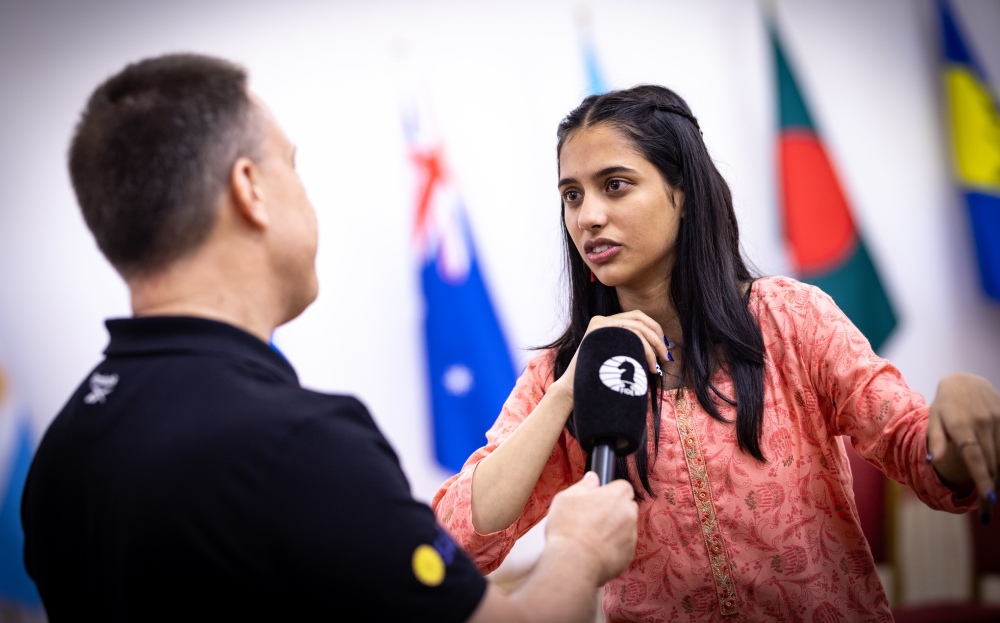
Divya Deshmukh, the 19-year-old International Master from Nagpur, Maharashtra, etched her name into chess history by defeating Grandmaster Humpy Koneru 1.5–0.5 in the tiebreaks to win the Women’s World Cup. She now follows in the footsteps of GM Alexandra Kosteniuk (2021) and GM Aleksandra Goryachkina (2023) as the third-ever winner of this prestigious title. In the two 15+10 rapid tiebreak games, Divya showed both resilience and composure. After missing a golden opportunity in the first game, which ended in a draw, she brought elite-level precision to the second. There, she equalised comfortably as Black, then seized control as Humpy slipped under time pressure—clinching the crown in emphatic fashion. With this remarkable win, Divya Deshmukh is now not only the 2025 Women’s World Cup Champion, but also one of the most exciting young stars in the world of chess. After the final game, an emotional Divya embraced her mother before giving a short interview: “It’s hard for me to speak now. Of course, this definitely means a lot, but there is a lot more to achieve, so I am hoping that this is just the start,” she said. https://www.youtube.com/watch?v=gEYitGH_RtI With this triumph, Divya not only secures the USD 50,000 first prize, but also automatically earns the Grandmaster (GM) title—the highest title in chess. In doing so, she becomes one of the very few players in history to achieve it by winning a major FIDE event rather than collecting the usual three GM norms and 2500 rating. Reflecting on this, Divya shared: “I still need time to process it. I think it was fate, me getting the Grandmaster title this way, because before this I didn’t even have one norm, and now I’m a Grandmaster.” Divya also qualifies for the 2026 Candidates Tournament, alongside the second and third-place finishers— GM Humpy Koneru and former Women’s World Champion Tan Zhongyi. A full prize-giving report with photographs is scheduled for later this evening. Up next: A closer look at today’s dramatic tiebreak games. Tiebreak Game 1: A missed opportunity FIDE President Arkady Dvorkovich was on hand to greet both finalists before the round, wishing them the best of luck in the decisive tiebreak. At exactly 12:00, the chief arbiter started the clocks for the first of two 15+10 rapid games. Divya opened with 1.e4, and in a surprise deviation from her usual 2…Nc6 systems, Humpy Koneru opted for the Petroff Defence (2…Nf6)—a line she had largely set aside in favor of the ultra-solid Berlin since late 2023. Humpy had played the Petroff extensively after becoming a Grandmaster in 2002, and she returned to it today with a very specific sub-variation in mind. On move 6, she chose 6…Bf5, a reliable and less theoretical side-line she had previously used to defeat Divya in the Tata Steel India Blitz 2023. This system gives White dynamic play in exchange for an isolated queen’s pawn (IQP), while Black aims to reach slightly better endgames by neutralizing the activity. Up until move 15, the players followed a well-known game between Leon Luke Mendonca and Arseniy Nesterov from the 2024 Biel Masters, which ended in a draw. At this point, Divya made a principled and bold decision: she played 20.d5, aiming to liquidate the IQP and open lines for her active minor pieces. Humpy responded instantly with 20…Rad8!, targeting the newly weakened center. In the ensuing tactical sequence, Humpy won the d5-pawn, but White had just enough piece activity to maintain dynamic equality. Then came the blunder. With the clock ticking down to her final 20 seconds, Humpy played 33…Re7, overlooking a tactical shot. Divya immediately responded with 34.Rd1!, threatening to trade rooks and win the bishop on g6 after 34…Qb8, due to the pin and pressure. The only defense was for Humpy to sacrifice her queen, entering a materially imbalanced but defensible endgame: rook, bishop, and pawn vs. queen. Despite the material imbalance, Humpy built a fortress, Divya had a chance to break through on move 37, but missed this opportunity and the game ended in a draw. Instead of 37.Rc8?, trading the rooks Divya should have played 37.Qb8+, picking up the a7-pawn. The point is that the natural 37…Kh7 fails to 38.Rc8! followed by 39.Rh8+ winning. “A big missed chance for Divya,” remarked former five-time World Champion Viswanathan Anand, who joined the official broadcast with expert commentary and praised both players for their fighting spirit. Tiebreak Game 2: Nerves, risk—and triumph With the score tied after the first rapid game, the pressure was at its peak as Humpy Koneru opened the second game with the Catalan Opening. In response, Divya Deshmukh chose the aggressive 4…dxc4, 5…Bb4+ variation—an ambitious and increasingly popular system at the top level, favored by elite Grandmasters like Dmitry Andreikin, Grigoriy Oparin, and Parham Maghsoodloo. In this line, Black accepts a pawn sacrifice, giving White a lead in development and long-term pressure on the dark squares. However, modern theory has shown that if Black times the pawn return correctly, the position can often simplify into a defensible or even equal endgame. “This opening does give you a chance to counterattack,” said Vishy Anand during the live broadcast, “but Divya will have to play passively for a few moves, which is not really her style.” Despite the slight passivity, Divya held on to the extra pawn heading into the middlegame, though at the cost of weaknesses on a5 and c6. Her pieces were slightly cramped, but the position remained balanced according to engines. Humpy’s major problem, however, was time. While Divya had over 11 minutes, Humpy was already under three. For the next 20+ moves, the players circled each other with careful maneuvers, but made little concrete progress. A draw looked imminent. And then came the turning point. With less than a minute left on her clock, Humpy suddenly played 40.e4?!, a central break that shocked commentators. After 40…dxe4, she immediately followed up with 41.d5?, a blunder that allowed Divya to strike with 41…Qe5!, seizing control. “A totally self-inflicted collapse by Humpy,” said Anand. “There
FIDE Women’s World Cup Final, Game 2: Elite-level precision as Humpy and Divya head to tiebreaks
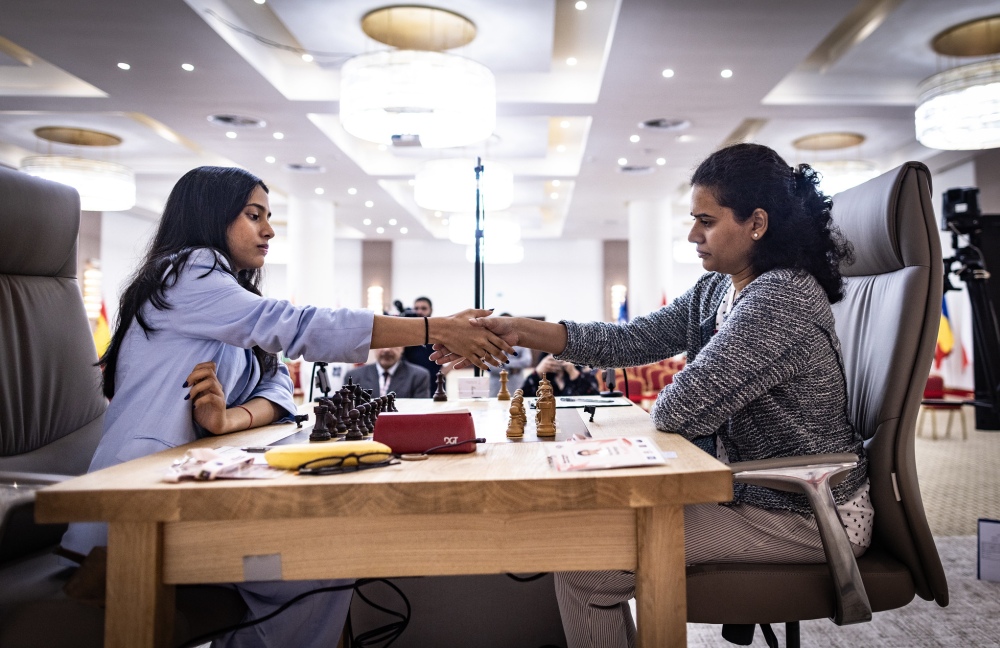
Tan Zhongyi clinches third place and candidates spot in a thrilling battle against Lei Tingjie The second game of the Women’s World Cup final ended in a solid draw. Humpy Koneru attempted to unbalance an equal position with an enterprising pawn sacrifice, but Divya Deshmukh defended accurately, and the game was drawn after 34 moves. “It should have been an easy draw, but I got into trouble for no reason,” Divya remarked candidly after the game. With both classical games drawn, the title will now be decided in tomorrow’s rapid tiebreaks. Humpy, the reigning World Rapid Champion, enters the playoff with strong credentials, but Divya has shown remarkable composure and resilience in previous tiebreaks, having already defeated Grandmasters Zhu Jiner and Harika Dronavalli in earlier rounds. “I think I’m going to give my best tomorrow,” said Divya. “She is of course a very strong player, but I’m hoping things go my way.” In the battle for third place, Tan Zhongyi emerged victorious against fellow Chinese Grandmaster Lei Tingjie. In an exciting encounter, Tan capitalized on a major blunder by Lei in the late stages of the game. With the win, she not only claimed the bronze medal but also secured a coveted spot in the Candidates Tournament. Tan, a former Women’s World Champion, has now achieved an impressive record in the three editions of the Women’s World Cup: two third-place finishes and one fourth place. Elite-level Precision as Humpy and Divya head to tiebreaks The second classical game of the Women’s World Cup final between Humpy Koneru and Divya Deshmukh was a showcase of top-tier accuracy. Both players recorded a remarkable 99% accuracy score, with an average centipawn loss of just three—a clear testament to the elite level of play on display. Humpy surprised with the fashionable Zukertort setup: 1.Nf3 2.e3 3.c4—a line used by players like Levon Aronian and gaining popularity in recent years. Though not a staple in Humpy’s repertoire, she had previously used it to score a notable win over IM Salome Melia at the 2024 New York Rapid & Blitz, where she clinched the World Rapid Championship title. As expected, Divya’s preparation was impeccable. With a series of precise moves, she comfortably neutralized White’s initiative and steered the game into a balanced queen and minor piece endgame. The position was dynamically balanced—Humpy had the bishop pair, but the closed center allowed Divya’s knights to hold their ground. After a lengthy think, Divya played 21…Ne4, a principled and engine-approved choice that invited complications. Humpy immediately seized the opportunity to transform the position with 22.Bxe4 dxe4 23.d5!, sacrificing a pawn to open the long diagonal and activate her bishop. Though down a pawn, White seized the initiative. Divya found herself under sudden pressure and explained afterward: “I got myself into a mess for no reason. I was trying to see if there was a win, but I missed Qb8.” That moment came on move 26: Despite being a pawn ahead, Black was caught in a bind. The knight on d8 was pinned and vulnerable, and mating threats loomed. Divya, showing great defensive prowess, played Kh7, eventually freeing herself with a precise …Nc6 maneuver. Though she had to return her extra pawn, the simplification allowed her to force a perpetual check, bringing the game to a balanced conclusion. With both classical games drawn, the final will now be decided in rapid and blitz tiebreaks tomorrow. According to an unofficial FIDE poll of 10,000 viewers, the odds are almost evenly split: 52% favor Divya, while 48% lean toward Humpy. The outcome now hinges entirely on their speed chess prowess and nerves under pressure. https://youtu.be/6Xj8N1NLW9Q Tan Zhongyi clinches third place and Candidates spot in thrilling battle Against Lei Tingjie In the other decisive match of the day, Tan Zhongyi overcame Lei Tingjie to secure the bronze medal and, crucially, the final qualifying spot in the 2026 Candidates Tournament, which determines the challenger for the Women’s World Championship. Lei opened with the Giuoco Pianissimo, a quiet but deeply theoretical variation of the Italian Opening—a line she had already employed multiple times during her semi-final clash with Humpy Koneru. Tan, well-prepared for the encounter, followed familiar territory from her Round 5 victory over Vaishali, but in this game, she allowed Lei the opportunity to pin the knight on g5 early after castling. “I actually didn’t expect her to play this opening. I had prepared this before when I played against Vaishali, and back then I made a mistake in the move order, but I reviewed it again, and I didn’t expect that she would play it today. I feel pretty lucky,” Tan confessed in a quick postgame interview. The first critical moment arose just out of the opening: This position has appeared in several top-level games, with players like Aronian and Vidit choosing the creative 12.Ra3!?, sacrificing the d4 pawn in exchange for swift rook activity. Instead, Lei introduced a novel idea: 12.Bb5!?. After 12…exd4 13.Nc4! dxc3 14.Nxb6!, the game took a sharp tactical turn: If Black greedily continues with 14…cxb2, White responds with 15.Bxb2 cxb6 16.Ra3!, followed by 17.Nh2 and 18.Rg3, setting up a devastating kingside assault in exchange for two pawns. Recognizing the danger, Tan wisely declined the material and prioritized piece activity and king safety with 14…cxb6. From that point on, both players followed the engine’s top line with astonishing precision, showcasing exceptional preparation and decision-making under pressure. The second pivotal moment occurred in the late middlegame: Here, Tan had a winning opportunity with 35…Qf1!, pinning the g2 pawn and threatening both mate and the rook on d4. However, spotting the correct follow-up—36.Rxe6 h5!—was far from easy. This subtle pawn move shuts down any escape via g4, and with …Qh1# looming, White would have been helpless. Tan missed the win, and Lei managed to regain balance with two pawns and a knight for the rook, entering a complex endgame. However, with the clock ticking down, Lei made a fatal error in a tense position: Here, 52.Kg3 would have prolonged
FIDE celebrates 5.5 million moves and announces prize winners for Social Chess Day Tournament
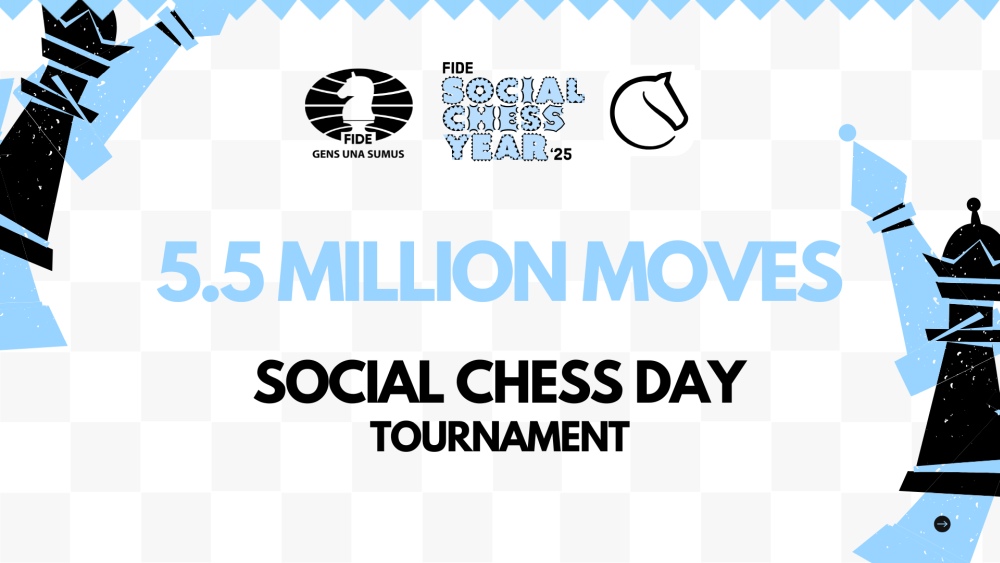
To mark International Chess Day 2025, FIDE and Lichess.org hosted a 24-hour global online blitz tournament as an open celebration of chess as a universal language. The response was overwhelming. More than 20,000 players joined the event, making it one of the largest social chess tournaments ever held. In total, 20,078 players took part, playing 85,252 games and making over 5.5 million moves. The format was a 5+3 blitz, and players could join at any time throughout the 24-hour period, making the event truly global and inclusive. This initiative was part of FIDE’s broader campaign for the Year of Social Chess, under the theme “Every Move Counts.” In keeping with that spirit, the event focused not on elite competition, but on connection, creativity, and community. As part of the celebration, hundreds of participants were randomly selected to receive prizes ranging from Olympiad invitations to training sessions with Grandmasters. UPD. Due to an incorrect file of prize draw participants initially provided by the platform, the first prize selection was carried out among those who were not eligible to participate in it. Once the error was identified and FIDE obtained a corrected file of prize draw participants, we have conducted a prize redraw in full compliance with the regulations. Attending the 2026 FIDE Chess Olympiad in Samarkand Five lucky participants have been awarded invitations to attend the opening ceremony and first round of the 2026 FIDE Chess Olympiad in Samarkand, including two nights of accommodation: Yatharth9680071234 legendaandivan Barinjaka Andrii_Nikolenko GalimovaTS FIDE Merchandise Vouchers Ten participants won €100 vouchers to spend on official FIDE merchandise: Denis2909 Dnyanesh1303 Timila CCY-OFICIALL-ACC666 avtarsingh86 CalebtalleyALT mahmod07777 XAJIK Jagma_is_baak ejderha35 “Chess Players” Photography Books Twenty participants will receive a copy of the “Chess Players” photography book, a visual celebration of the game and its people: adzag MihailSandykov Serg80 baazbahadur HENKBATSBEK Jae_Ftg Darkstar108 Thiago_BRC mashariki_1 Turaarrr Mehmet_Tirane Krishnay13 HiradShahbazi88 CBA4006IMANFAHIM TLTLTLTLTLT AaryanKov Ptahotep denizefe34 Mandalorian99 xilefkerl Online Experiences with Grandmasters 1-on-1 Training with GM Lei Tingjie ALITA20 Motivational Talk with GM Nijat AbasovFifty participants were invited to a group session led by GM Abasov. The winners are: No55gaming Diamantesco SMKN30 vincents82 Michele_11 Darrennswana ysxy512 IvanKaramazov123 Brilliant_Machine NareshDusa williebob Cybernautilus poxay Blue_Commander Godspower16 VincFrancisco_Bacoor dumDudum Favian_2889 fjcufujfhxhzd Cvillarino22 dimitris1 Eidan1803 MZM10 Ahimalya_2025 Spitzwegerich_1 lolomezzo A-prox-mate MungiwaraNoGoofy Leilin2004 B342 fcvomond NoahCizdziel CARLA8787 Mikhail_P Lotta14 uditbkp123 magnussen0 daydreamerfun AluDilu pietrek_c DIgor1706 Kollagogom2 abhinavsreejith2012 Threee_Move_Wonder maniatul Zhendosik_sigma theonlywayusmate27 Bart1815 Yurij291212 shivanshwins Online Simultaneous Exhibitions with GrandmastersThe following participants were selected to play in online simuls with some of the world’s top players: With GM Humpy KoneruPs1803, Prihaan_porwal, Inumaki_toge, SayeedHazim, THUNDER_1102, JagaranA1, jens_g, Alejandritok7vell, Patzekatze, tryandprepme With GM Praggnanandhaalipson4u, Asia_1345, franmaco, DenisNov, pipopopi, akpap, elmagnificocolcho, Grandmaster-sammy, hareramj, pratsfares With GM Vaishali Rameshbabukamilen777, MEAT17, Aathvik, franciscocodoceo, DanPoki, Pepsiboyvaca, Sweetlake, Sashka228, diuberjesus14, hisforhenry With GM Tan ZhongyiCATF41, frankfreith, kashalot138, Sameer-AlSayed-2010, bhootbangla, ManqayiVuyo, Mohsen_Dj, LEZGIN-05, mukyducky, marcochess2021 With GM Arjun Erigaisihetman1968, s_titan1388, Ankalk, Legend1001, RY6973, WMANIMSARA, marranin, Sanubcg, Boldoo1, pra777 With GM Valentina Gunina (with lecture)amitgond, Ultra_Instinct2008, DrPurgerstein-2008, Terellel, RL1122, mathbro, NikTash, Magnusthelegendary, Sigma_001, EKAMDSINGH9 With GM Anish GiriJohnHiggins98, brauberg25, TowelaKaira, akm133, MathiasSanchez_UDEP, alexlamoc, easy_Win_lol, AbardomVladimir dmare, The_god_of_chess_001 With WGM Anna Shukhman (with lecture)Xaviersuper, Kavishrc, Rumochka_master, Herzatimer, Gauravviiii, Basher-Ghazal, sianbeaz, Vombrabro, Cxb451, migs423 Game Analysis and Q&A with GM Anna Muzychuk Twenty participants earned the opportunity to take part in a game review and Q&A session with GM Anna Muzychuk: amirreza_g7 AkiroOnFire sussasun Raghavsingh2426 brnvstrncyagmur avjd thaihung1532015 JuwanJJK eduardillo Thesonucguy KokulskiAleksei Bobbyschrodinger rathodtushar iHaidi92 flash_9110 AlexStargazer ThatAdam mamzouj yoooi romanbier This event was not about titles or final standings, but about participation and connection. It demonstrated that chess can unite people from every corner of the world. To everyone who joined the tournament: thank you. Every move counts. And every one of you helped make it count on July 20.
List of teams qualified for 2nd FIDE Chess Olympiad for People with Disabilities

The 2nd Chess Olympiad for People with Disabilities will take place from October 19 to 26, 2025, in Astana, Kazakhstan. Organized by FIDE and hosted by the Kazakhstan Chess Federation, this major international event highlights FIDE’s ongoing commitment to inclusion and accessibility in the global chess community. The Olympiad will bring together up to 34 teams from across the world, composed of players with visual, hearing, and physical impairments. Each team will consist of four players (with at least one from each gender), one captain/reserve, and one accompanying person. The competition will be held at the Paralympic Training Centre in Astana, a venue specially adapted to accommodate the needs of all participants. So far, 32 teams have qualified for the event, with two teams to be nominated by the FIDE President. Continental qualification Europe – 9 teams Poland Hungary Israel Ukraine Germany Croatia Czech Republic North Macedonia Serbia Asia – 7 teams FIDE Philippines India Iran Bangladesh Myanmar Uzbekistan Americas – 6 teams Cuba Venezuela Argentina Colombia USA Chile Africa – 5 teams Egypt Zambia Zimbabwe Tunisia Uganda Teams from the FIDE affiliated organizations – International Associations of Players with Disabilities – 3 teams International Braille Chess Association (IBCA) International Chess Committee of the Deaf (ICCD) International Physically Disabled Chess Association (IPCA) Nominations of the FIDE President – 2 teams TBD TBD Teams from the hosting federation – 2 teams Kazakhstan 1 Kazakhstan 2 Photo: Mark Livshitz The first edition of the Chess Olympiad for People with Disabilities was held in Belgrade, Serbia, in 2023, marking a historic milestone for accessible chess. The event drew global attention for its inclusive spirit and high-level organization, laying the foundation for a growing tradition. 2nd FIDE Chess Olympiad for People with Disabilities Regulations (PDF) For registration and queries, federations are encouraged to contact: dis@fide.com.
FIDE Women’s World Cup Final, Game 1: Narrow escape for Humpy Koneru; solid start by Divya Deshmukh
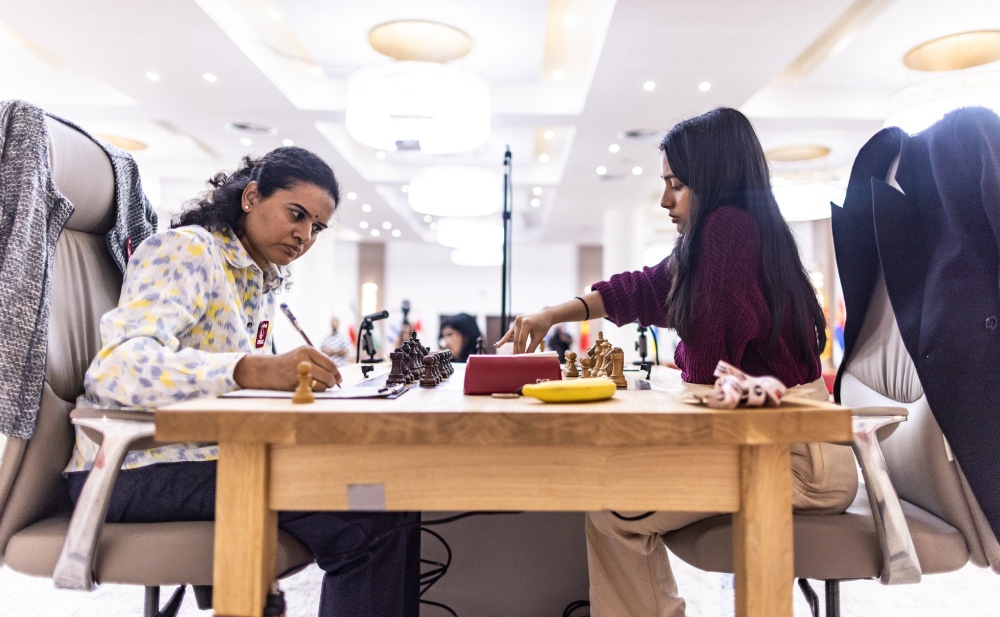
Tan Zhongyi and Lei Tingjie also split the point in a balanced game The first game of the final was as exciting as it gets. Divya unleashed some excellent opening preparation and was on the verge of scoring a win in under 25 moves. However, Humpy defended tenaciously and capitalized on a few inaccuracies to salvage a draw. The second game of the match will be played tomorrow, with Humpy having the white pieces. In her post-game interview, Humpy admitted she had narrowly escaped defeat: “I think she was clearly better after 12.Rb1 instead of 12.Nc4. After that, I’m not sure what was going on, but it was very complicated.” In the third-place match, Tan and Lei split the point just after the 30-move threshold. Lei will have the white pieces in tomorrow’s second game, with the winner securing the final Candidates qualification spot. Let’s take a closer look at the games. Although Divya is comfortable playing both 1.e4 and 1.d4, the former has been her weapon of choice throughout the tournament in Batumi. So, it came as a surprise to see her open today’s game with 1.d4 — and even more so when Humpy Koneru responded with the Queen’s Gambit Declined, a defence she had largely set aside since 2005. Humpy reintroduced the Queen’s Gambit Declined to her repertoire in 2023, but has used it sparingly compared to her other openings. Her most recent outing in this line — a loss to Lei Tingjie in Norway Chess 2024 — followed the variation featured in today’s game. Reflecting on that earlier defeat, Humpy said in her post-game interview: “I think that she prepared on this game and I just misplayed the opening and she got a big advantage.” The first critical moment came very early. According to the database, this position has appeared in about thirty elite-level games — all of which continued with 7.f3, reinforcing the e4 pawn and guarding against 7…Nxe4. But Divya deviated with 7.Be2 — a rare move, though not a novelty. GM Evgeny Bareev had employed it against GM Vassily Ivanchuk back in 1992. Today, engines rank it as their third choice. Humpy spent around ten minutes considering her reply and ultimately declined the pawn with 7…Bb7, possibly wary of running into home preparation. Undeterred, Divya castled and offered the pawn again. This time, Humpy accepted — and suddenly the game became sharply tactical, reminiscent of the original Bareev–Ivanchuk clash more than three decades ago. According to the engine, Divya missed an opportunity to achieve an opening advantage on move twelve but certainly on move fourteen she went wrong. In this critical position, the computer recommends 13…Kd8 for Black. After 14.Qe2 Re8, the position appears dangerous, but with precise play, it remains objectively equal. However, Humpy opted for 13…Kf8?, a natural-looking move that unfortunately gave her opponent a real chance to seize the initiative. “I don’t remember exactly the reasons, but I felt that 13…Kd8 was the wrong move,” Humpy said after the game. Sensing that an opportunity had arisen, Divya went into deep thought but ultimately missed the most punishing continuation. She played 14.Bxb7?, grabbing material but allowing the position to equalize after 14…Qxb7 15.Qe2 Nc6 16.d5, when the excellent defensive resource 16…h5! returns the extra piece and neutralizes White’s initiative. “I felt that after 16…h5 I was out of danger,” Humpy reflected. https://www.youtube.com/watch?v=G28SnnLdqsQ&t=7s Instead of capturing on b7, Divya should have played 14.Qe2!, maintaining a crushing +2.5 advantage according to the engine. The move intensifies the pressure on the exposed Black king and keeps White’s attacking momentum alive. Of course, finding such a precise continuation over the board, especially under time pressure, is never easy. Divya was visibly distressed at the end of the game after missing her chance to secure the win — the disappointment was evident on her face as she sat at the board. Even so, both players graciously spent time with fans who had been waiting all afternoon for a photo opportunity and a chance to meet their chess idols. Although all eyes were focused on the main game of the finals, the battle for third and fourth place was equally significant. The winner would secure the third qualifying spot for the Candidates Tournament, plus a €5,000 pay jump. Both Chinese players, good friends and frequent training partners, brought their best to the board. Tan opened with 1.c4, and the game soon transposed into a well-known position from the Queen’s Gambit Declined, Exchange Variation. Both players blitzed out their moves rapidly, demonstrating excellent theoretical knowledge. Instead of pursuing the mainstream minority attack plan—characterized by 10.Qc2, followed by 11.Rab1 and a later b4-b5—Tan opted for a less common approach with 10.a4. The idea was to play 11.a5, aiming to clamp down on the queenside. Recent games from elite players such as Caruana, Praggnanandhaa, Vidit, and Grischuk seem to support this strategy. The pace slowed as the game transitioned into the middlegame around move fifteen. Both players maneuvered their pieces carefully, seeking out the best squares. Their accuracy remained impeccable—no outright mistakes were made. However, a couple of small inaccuracies by Tan on moves 29 and 30 shifted the balance toward Lei. Though the engine suggests Black holds a modest +1 positional advantage—roughly equivalent to a pawn—the position was blocked, and White’s knights stood powerfully in the centre. Black’s slight edge mainly lay in a better pawn structure. Lei offered a draw just as her clock ticked down to fifteen minutes. In the end, both players left the hall together in good spirits, their friendship evidently undiminished by the fierce contest. Follow the games live and watch the action with expert commentary provided by GM Valeriane Gaprindashvili and IM Almira Skripchenko on the FIDE YouTube channel. Written by IM Michael Rahal (Batumi, Georgia) Photos: Anna Shtourman About the tournament: Scheduled to take place from July 6th to July 28th, the 2025 FIDE Women’s World Cup will gather together in Batumi (Georgia) the world’s best female chess players. A total of
International Organizer Seminar announced as part of World Youth Chess Championship 2025
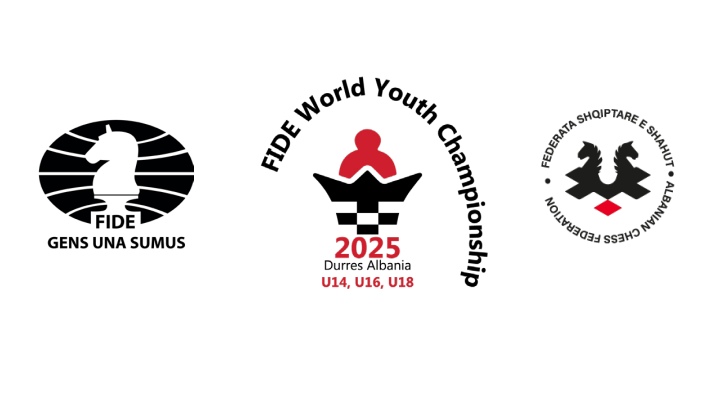
As part of the World Youth Chess Championship 2025 in Durrës, Albania, the Albanian Chess Federation, in cooperation with FIDE WOM and under the auspices of the FIDE Events Commission (EVE), will host the International Organizer Seminar. This seminar is designed to train and certify organizers of international chess events in compliance with FIDE regulations. Participants who successfully pass the final exam will receive the official EVE IO Norm Certificate, issued by FIDE. Seminar details Dates: October 11–12, 2025Location: Grand Blue FAFA Resort Hotels, Durrës, AlbaniaLanguage of instruction: EnglishParticipants: Maximum 20Participation fee: 100 Euros Schedule Saturday, October 11Session 1: 10:00 – 13:00 (CET +1)Session 2: 14:00 – 16:30 (CET +1)Sunday, October 12Session 1: 10:00 – 13:00 (CET +1)Session 2: 14:00 – 15:30 (CET +1)Final Exam: 15:30 – 16:30 (CET +1) Seminar topics FIDE Events Commission Regulations (mission, structure, competition regulations, bid procedure) FIDE Title Regulations FIDE Rating Regulations How to Organize Chess Tournaments Fair Play Guidelines FIDE LecturerOzgur Solakoglu (TUR) – IO, IA, FT, FM Assistant LecturerAnastasia Sorokina (AUS) – IO, IA, FPE, FT, WIM Special Participation offer for womenAs part of the FIDE WOM event, the first 10 registered female participants will receive free participation. Additionally, the Albanian Chess Federation has the right to nominate 2 participants free of charge. Registration & contact: nadzeya.krauchuk@gmail.com Parallel events like cultural visits, chess events and seminars, will be announced in due time.

